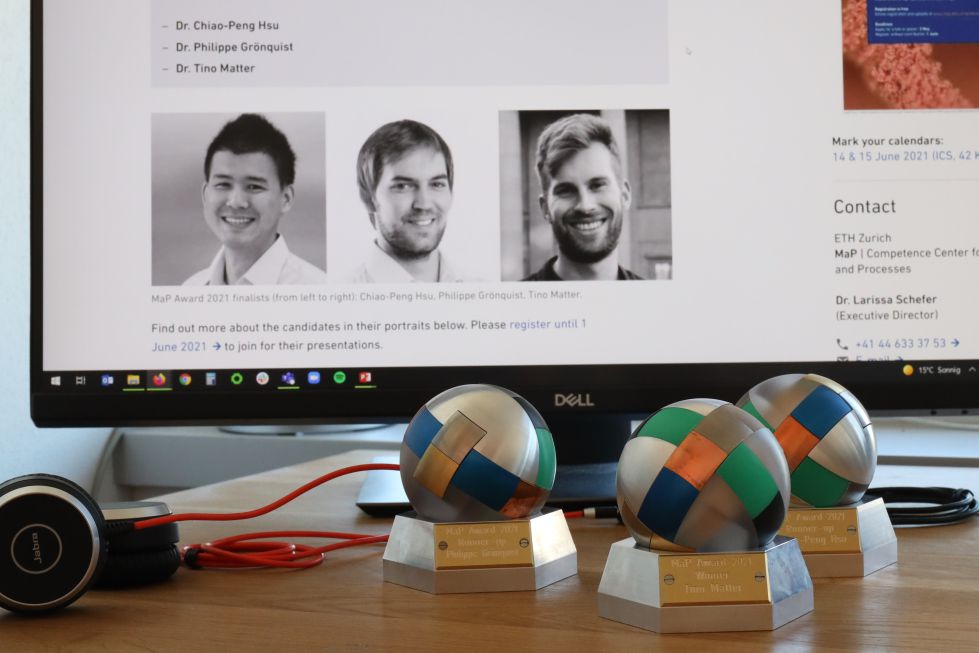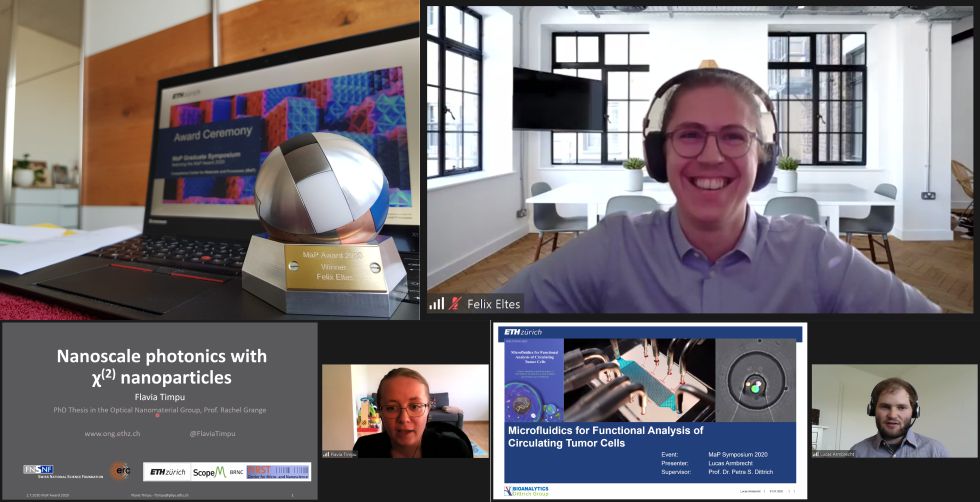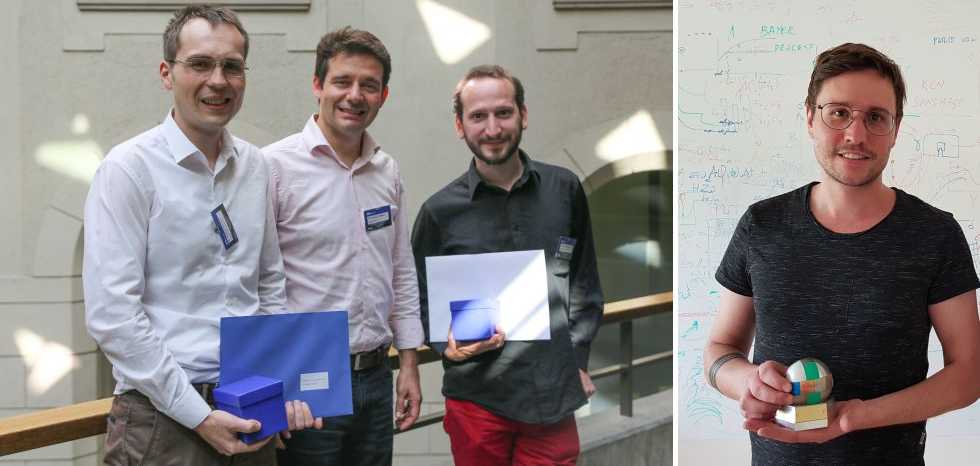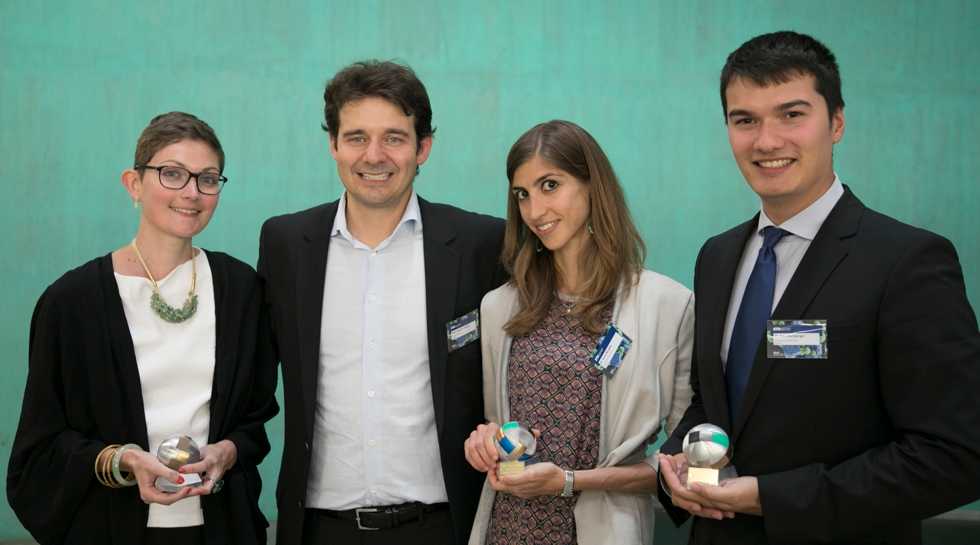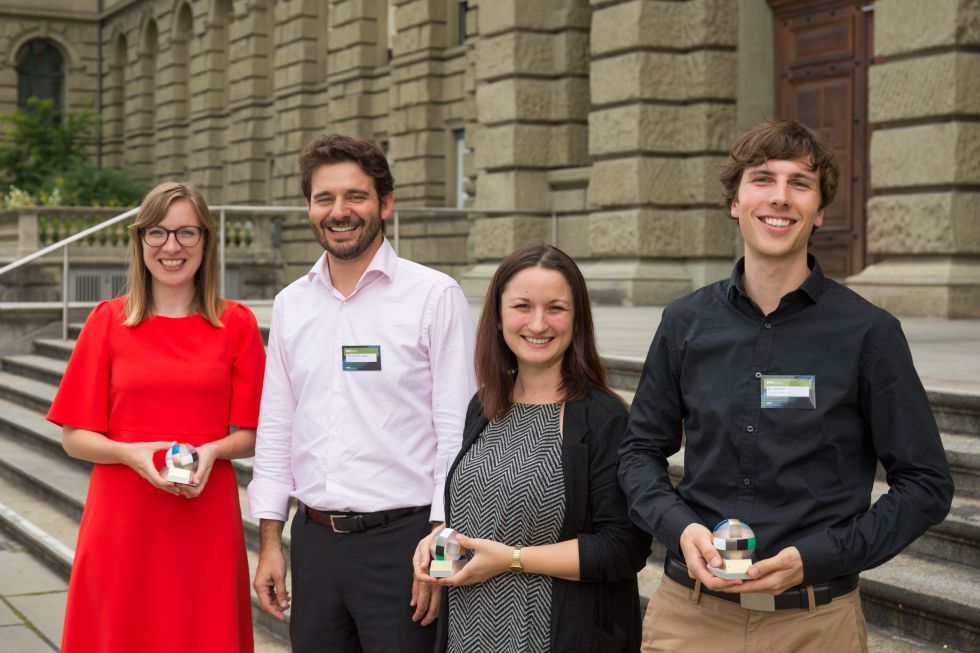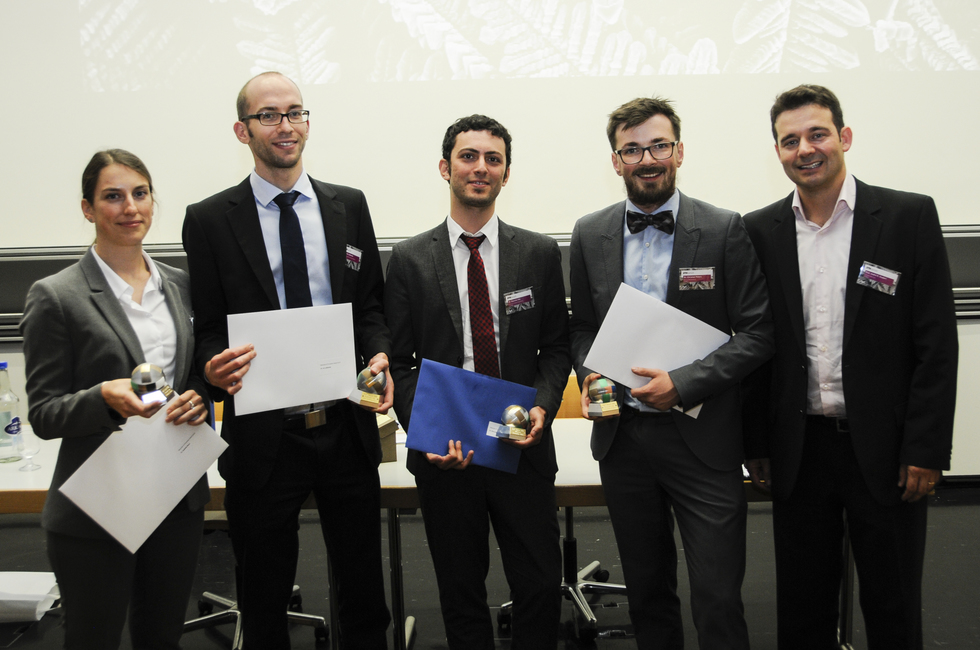MaP Award 2014-2021
Every year the MaP Doctoral School awards a prize for the most promising doctoral thesis of ETH Zurich in the field of Materials and Processes.
MaP Award 2021
Our sincere congratulations go to Dr. Tino Matter for winning the MaP Award 2021! The prize recognises his impressive doctoral thesis on 'Uniting Bioactivities in Hybrid Nanosystems for Wound Healing'. In his work, Dr. Matter spearheaded the development of bioactive metal oxide nanoparticle-based tissue adhesives for wound healing applications in an interdisciplinary collaboration with leading clinical experts. He demonstrated that his technology is superior to commonly used fibrin-based tissue sealants and considerably improves the survival of skin grafts compared to the clinical gold standard. Dr. Matter completed his doctoral degree under the supervision of Prof. Inge Herrmann in the Nanoparticle Systems Engineering Laboratory (D-MAVT & Empa). The technology Dr. Matter developed is commercialised by the startup external page anavo.
We would also like to acknowledge the two other MaP Award 2021 finalists, Dr. Chiao-Peng Hsu (Laboratory for Soft Materials and Interfaces, D-MATL) and Dr. Philippe Grönquist (Wood Materials Science Group, D-BAUG & Empa) for their promising doctoral theses and their excellent presentations at the MaP Graduate Symposium 2021.
Find out more about the finalists in their portraits below. More information about the MaP Award.
Congratulations again to all three MaP Award 2021 nominees!
Nominees for the MaP Award 2021
Tribological Insights into Shear Thickening Suspensions
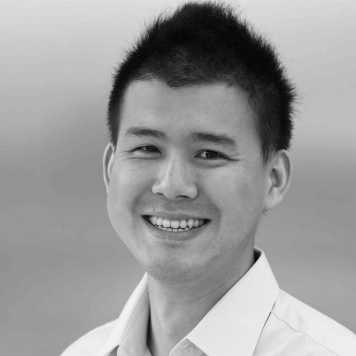
Short CV
Chiao-Peng Hsu grew up in Taiwan. He obtained his BSc and MSc in materials science from National Tsing Hua University and EPF Lausanne. At ETH Zürich, Chiao investigated the microscopic origin of shear thickening in dense suspensions in the Laboratory for Soft Materials and Interfaces led by Prof. Lucio Isa, receiving a PhD in 2020. He is now a postdoc at TU München in the Laboratory for Cellular Biophysics led by Prof. Andreas Bausch.
Your PhD project in 2 sentences
We identify the crucial importance of the particles’ surface design for the high-shear macroscopic rheological response of their suspensions. Our work provides a framework for anticipating and preventing unwanted flow behaviour in processing applications, and contributes with design recommendations for engineering discontinuous shear thickening in dynamically responsive materials.
Why did you choose this PhD project?
As a material scientist, I am always eager to know how the material properties are determined by their microstructures and microscopic mechanisms. It was clear to me that I would like to work on an experimental PhD project to design and characterize the building blocks and link them to the macroscopic properties. To this end, I was fascinated by exploring materials using the colloidal-model-system approaches.
Future Plans
In my postdoctoral research, I am employing my expertise in model colloidal materials and soft matter to explore the reconstitution of integrin adhesion complex. My goal is to explore open experimental challenges and push the boundaries of biomimetic materials mimicking increasingly more complex biological processes.
Smart Manufacturing of Curved Mass Timber Components by Self-Shaping
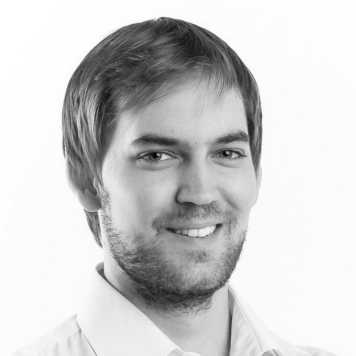
Short CV
Philippe Grönquist was born and grew up in Switzerland, where he studied Civil Engineering at ETH Zurich with majors in materials and mechanics & construction management. Philippe conducted his PhD from 2016 to 2020 in the Wood Materials Science Group led by Prof. Ingo Burgert. Since 2020, he is working as a postdoctoral researcher on the topic of innovative timber structures at the Chair of Timber Structures led by Prof. Andrea Frangi.
Your PhD project in 2 sentences
Our work proposes to replace the tedious procedures for bending wood at large-scale to produce curved timber components by an efficient and biomimetic self-shaping process. The developed process could be demonstrated by the self-shaping manufacturing of curved cross-laminated timber lamellae for a 14 m high timber tower.
Why did you choose this PhD project?
This project offered a unique opportunity to gain and apply fundamental knowledge in industry by working together with a renowned architecture institute and a worldwide leading company to produce and construct free-form timber. Combined with my background and fascination for the material wood, the decision to pursue this project was a no-brainer.
Future Plans
I plan to continue working on research and development in wood materials, timber engineering, and construction. Thanks to their sustainable characteristic, wood and wood-based products are currently the booming materials in the construction industry, and without a doubt, the building materials of the future.
Uniting Bioactivities in Hybrid Nanosystems for Wound Healing
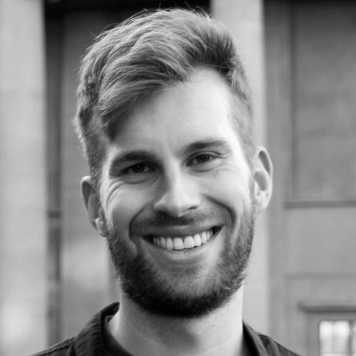
Short CV
Already at a young age, Tino Matter was fascinated by the opportunities that new technologies offer us. After focussing on computer science and maths in high school, Tino enrolled in the interdisciplinary nanoscience program at Uni Basel. After a physics-heavy BSc and MSc, he moved into the biomaterials field for his doctorate with Prof. Inge Herrmann at ETH Zurich & external page Empa to directly impact people's health. Now, as a Pioneer Fellow at ETH, Tino is building the external page startup anavo (former nanoglue) based on his research.
Your PhD project in 2 sentences
We have harnessed established production techniques to produce novel bioactive material combinations at the nanoscale. As demonstrated in vitro and in vivo, our nanoparticles have seemingly orthogonal beneficial effects that are highly beneficial for wound healing.
Why did you choose this PhD project?
Our society profits immensely from scientific and technological progress. During my interdisciplinary studies in nanosciences, I learned to appreciate the value that is generated when different scientific branches connect to create new technologies.
Passionate about improving people's lives, I wanted to harness my scientific knowledge in a field with a big and immediate impact: Medicine. I discovered a project at ETH Zurich and Empa SG that aimed to explore the medical uses of metal-oxide nanoparticles. What started as a small project turned into an award-winning master's thesis and a successful doctorate.
Future Plans
I am working on building a company based on the technology developed during my doctoral studies. My eventual goal is to launch our nanoparticle system as a platform technology for a wide spectrum of different wounds.
MaP Award 2020
Our sincere congratulations to Dr. Felix Eltes for winning the MaP Award 2020! He is recognised for his outstanding doctoral thesis entitled 'Barium Titanate Pockels Modulators Integrated With Silicon Photonic Circuits', a project accomplished in collaboration with IBM Research Zurich. In his work, Dr. Eltes has established a significant milestone in the field of quantum photonics, proving that integrated BaTiO3 electro-optical modulators can be used as optical switches at cryogenic temperature. These results illustrate not only the potential of the technology but also the breadth of Felix' work and his capability to leave an impact in very different scientific communities. Felix is a gifted experimentalist with a perception spanning the scope from aspects of fundamental physics to the practical realisation of devices. Dr. Eltes earned his doctoral degree under the supervision of Prof. Manfred Fiebig in the Laboratory for Multifunctional Ferroic Materials at D-MATL.
We also recognise the two other MaP Award 2020 finalists, Dr. Flavia Timpu (Optical Nanomaterial Group, D-PHYS) and Dr. Lucas Armbrecht (Bioanalytics Group, D-BSSE) for their promising theses, which they presented on the occasion of the MaP Graduate Symposium 2020.
Find out more about the candidates in their portraits below. More information about the MaP Award.
Congratulations again to all three MaP Award 2020 nominees!
Nominees for the MaP Award 2020
Barium Titanate Pockels Modulators Integrated With Silicon Photonic Circuits
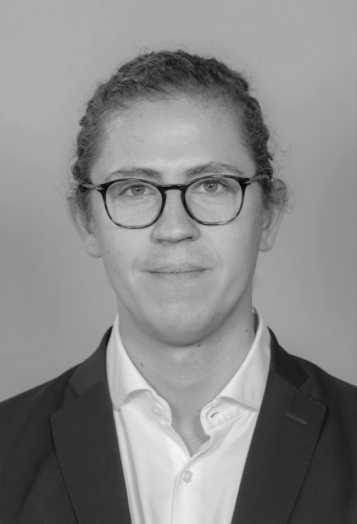
Short CV
Felix Eltes grew up in Sweden. He holds a MSc in Engineering Nano Science from Lund University, Sweden, and a PhD in Material Science from ETH Zurich. As an joint PhD student of the Multifunctional Ferroic Materials and external page IBM Research, under the supervision of Prof. Manfred Fiebig, he developed a technology platform for optical transceivers based on integration of novel materials. Today, Felix is a co-founder of external page Lumiphase AG, a start-up aiming to realize the commercial potential of the novel optical transceiver technology.
Your PhD project in 2 sentences
Integrating a new material in an existing technology platform for optical communications to improve the performance and to enable novel applications.
Why did you choose this PhD project?
It was an exciting opportunity to work on a project bridging from fundamental materials research to real-world applications. The clear application was something that motivated me during my PhD. It was made even more exciting by the opportunity to explore completely novel applications of the technology which were enabled by our technology.
Future Plans
At Lumiphase we are working to bring the technology I worked on in my PhD to the market for applications in optical communication.
Linear and Nonlinear Optics With Metal Oxides: From Single Nanoparticles to Metasurfaces
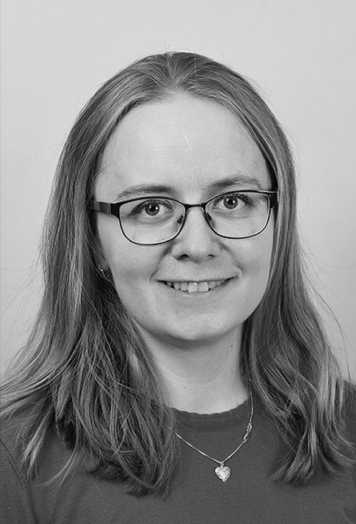
Short CV
Flavia Timpu is currently a post-doc in the Optical Nanomaterial Group where she focuses on creating photonic nanostructures that shape light efficiently over lengths shorter than the wavelength. She studied Physics at ETH Zurich, where she then continued with a PhD under the supervision of Prof. Rachel Grange, working at the intersection of optics, photonics and material science at the nanoscale.
Your PhD project in 2 sentences
Our work proposes to employ two metal oxides, BaTiO3 and LiNbO3, fabricated as nanoscale resonators, which enhances their nonlinear optical conversion efficiency inspite of their reduced volume. The full optical characterization and the fabrication methods we propose for these two materials can be used to develop small footprint devices for a broad spectral range, such as single photon emitters, nonlinear active metasurfaces and nonlinear flat optics or nanomodulators.
Why did you choose this PhD project?
Nanophotonics is a very hands-on research field which gives you plenty of room to develop and test new ideas and to rediscover the same materials at different size scales and application areas. Before I decided to embarck on my PhD project, it was clear to me that it will allow me to get creative with optical setups, have many collaborations with material scientists and work towards devices with very practical applications.
Future Plans
As a postdoctoral researcher, I am employing the knowledge I gained about single dielectric nanostructures to develop devices with emergent optical properties, that also exploit more then one property of the material they are made of. My goal is to achieve active metasurfaces and active nanostructures and integrate them into lab-on-a-chip architectures.
Microfluidics for Functional Analysis of Circulating Tumor Cells
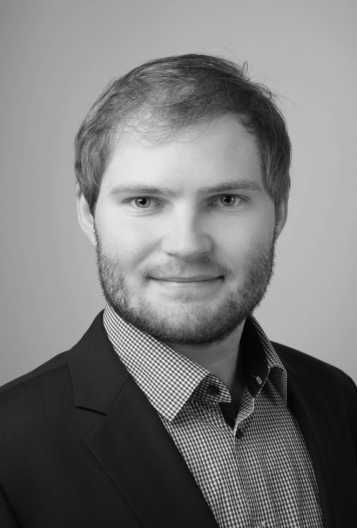
Short CV
Born in 1989 in Germany, Lucas Armbrecht studied Microsystems Engineering at the University of Freiburg im Breisgau with a focus on sensor applications in Life Sciences. In parallel, he worked for several research institutes and gained industrial experience in Stockholm and Zurich. From 2015 on, he conducted his PhD at ETH Zurich in the Bioanalytics Group led by Prof. Petra S. Dittrich. Currently, he is working as a project manager for MBV AG in Stäfa.
Your PhD project in 2 sentences
If you want to investigate how and why cancer is spreading, you need to be able to detect and isolate a single cancer cell from billions of blood cells and keep the cell alive during this process. In my PhD, I developed a microfluidic platform that fulfills all these requirements and applied it to study the behavioural differences between normal cells and these so-called circulating tumor cells.
Why did you choose this PhD project?
Similar to most other people, I know people who suffered or died from cancer. When learning more details about the formation of metastases during my master studies, I became aware that the actual problem with cancer is not the primary tumor, but (micro)metastases that often lead to relapse after treatment. I became curious to find out how the misbehavior of a single cell can ultimately lead to the collapse of the whole organism. How do tumor cells manage to travel through the body, escape the immune system, and colonize distant tissues? As a microsystems engineer, I quickly realized that I can best contribute to solving this fundamental question if I focus on the development of novel tools for that purpose. With this in mind, I applied for a PhD position in the Bioanalytics Group in the field of single-cell analysis and was lucky enough to get hired.
Future Plans
During my PhD I have partnered with start-ups and industrial partners to test if some of my findings could actually be turned into commercial processes and products. I realized that research in an industrial environment works different than in academia and found out that developing “real products” was what I wanted to do in future. This is why I decided to leave academia after finishing my PhD and I am now working as a RnD project manager at MBV AG in Stäfa near Zürich to develope the next generation of microbial air samplers for the pharmaceutical industry. In this versatile position, I do greatly benefit from the interdisciplinary knowledge and all the contacts to research institutes and companies worldwide that I established during my time as a PhD student.
MaP Award 2019
Many congratulations to Dr. Vladimir Paunović for winning the MaP Award 2019! This is a recognition for his outstanding PhD thesis entitled 'Catalytic Processes for Natural Gas Valorization via Bromine Chemistry'. In his work, Dr. Paunović uncovered novel catalytic materials enabling the highly sought advances in the chemical processing of methane, which is the key feedstock to sustain the production of commodities until fully renewable routes are economically favourable. Dr. Paunović earned his doctoral degree under the supervision of Prof. Javier Pérez-Ramirez in the Advanced Catalysis Engineering group at D-CHAB.
We would also like to recognise the two other MaP Award 2019 finalists, Dr. Nicolas Broguière (Tissue Engineering and Biofabrication, D-HEST) and Dr. Manuel Schaffner (Complex Materials, D-MATL) for their promising PhD theses, which allowed them to present their work on the occasion of the MaP Graduate Symposium 2019.
Find out more about the candidates in their portraits below. More information about the MaP Award.
Congratulations again to all three MaP Award 2019 finalists!
Nominees for the MaP Award 2019
Engineering of Synthetic Extracellular Matrix Analogues Supporting and Guiding Neurons
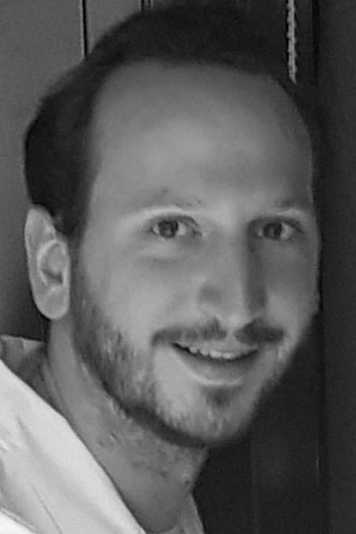
Short CV
Nicolas Broguière studied engineering at the École Polytechnique in Paris after a CPGE in mathematics/physics at Champollion in Grenoble. Following a double degree at KTH in Stockholm, majoring physics and neurobiology, he did his PhD at ETH Zurich in the Tissue Engineering and Biofabrication lab, supervised by Prof. Marcy Zenobi-Wong. He is now a postdoc at EPF Lausanne in the Stem Cells Bioengineering lab led by Prof. Matthias Lutolf.
Your PhD project in 2 sentences
We developed hydrogel-based techniques addressing a variety of challenges in tissue engineering, including the formation of pores of tunable size in synthetic hydrogels in the presence of cells to control cell invasion and gel stability, the 3D micropatterning of growth factors for cell guidance, and the cross-linking of hydrogels with ever improved kinetics/tunability and biocompatibility using enzymatic couplings. These tools enabled several advances for neural tissue modeling in vitro and towards guided regeneration in vivo, including the culture of long-term stable electrically active 3D neural networks, the regeneration of nerves through synthetic gels, and the 3D guidance of axons in brain-mimetic matrices.
Why did you choose this PhD project?
I wanted a project that targets clinical problems, and I loved the idea of developing tools that could lead to new strategies to treat devastating and currently intractable conditions like spinal cord injury. I also wanted a PhD project at the interface between physics and neurobiology to make the most of my training, so 3D axon guidance with two photon patterning of growth factors was a dream match. Finally, I appreciated that Prof. Zenobi-Wong was so committed to the success of her students, as there is nothing more important than a supportive mentor for a young researcher.
Future Plans
As a postdoc, I am still working on retro-engineering biological processes to reconstruct tissues more faithfully, but now with a new focus on in vitro disease modeling for personalized medicine. Biomedical engineering is progressing at an astonishing rate, with new tools such as organoids, biofabrication techniques, single-cell profiling, machine learning, protein design and gene editing revolutionizing our understanding of biology and our bioengineering possibilities. I am grateful to be part of this community and look forward to seeing these technical advancements pave the way to medical breakthroughs.
Catalytic Processes for Natural Gas Valorization via Bromine Chemistry
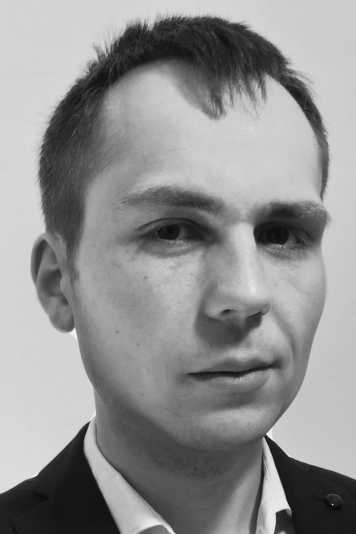
Short CV
Vladimir Paunović was born and raised in Serbia. He obtained BSc and MSc degrees in chemical engineering from the University of Belgrade, completing his MSc thesis at the Max Planck Institute in Magdeburg (Germany) in 2013, in the group of Prof. Kai Sundmacher. He earned his PhD at ETH Zurich in the Advanced Catalysis Engineering group under the supervision of Prof. Javier Pérez-Ramírez and currently pursues postdoctoral research in the same group.
Your PhD project in 2 sentences
Conversion of methane and other light alkanes into value-added chemicals and liquid fuels via bromine-assisted activation constitutes a ‘dream technology’ that could transfigure the valorisation of abundant and inexpensive natural gas, which is the key resource to sustain the transition to the renewable era. In my PhD project, we combined different synthesis and characterisation methods with in-depth kinetic evaluation and detection of reaction intermediates by advanced operando techniques to rationalise the structure-activity relationships and develop catalysts enabling the efficient bromine recovery, which has been the long-standing challenge for the practical implementation of this route.
Why did you choose this PhD project?
My research topic captivated me as it combines both the fundamental and practical essences of chemical engineering – the understanding of relationships between the materials and the processes at different size- and time- domains through an interdisciplinary approach, which endeavours to develop a technology that could help to sustain our society in the years to come. It was perfectly combined with the research philosophy and team spirit of the Advanced Catalysis Engineering group, enabling me to continuously learn and develop, while trying the solve the problems of substantial practical interest.
Future Plans
My current postdoctoral research is focused on the extrapolation of the gained knowledge on other process steps within the halogen-based production of commodities from natural gas, aiming to bring this technology to commercialisation. I plan to continue my career in the field of heterogeneous catalysis developing the processes that cope with energy and materials demands of our society.
Additive Manufacturing of Fiber-Reinforced Soft Materials for Medical and Robotic Applications
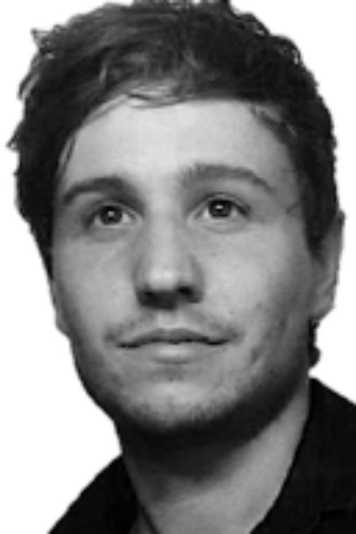
Short CV
Manuel Schaffner holds a MSc in Interdisciplinary Science and a PhD in Material Science from ETH Zurich. During his PhD in the Complex Materials group led by Prof. André Studart, he developed the know-how for 3D printing of fiber-reinforced soft materials. His research experience also counts a visiting period at Harvard University, where he carried out research on bioinspired materials. Today, Dr. Schaffner is CEO of the ETH Spin-off external page Spectroplast AG that aims to bring high-precision silicone additive manufacturing to the mass market.
Your PhD project in 2 sentences
Expanding the range of materials accessible to 3D printing.
Why did you choose this PhD project?
Working on an emerging field that has a great appeal on the scientific level as well as on the technological side fascinated me from the start. It has been my vision to have a positive impact on society by fostering technology transfer from a research lab to the mass market, hopefully impacting many industries and lives.
Future Plans
With Spectroplast AG, our vision is to bring industrial scale silicone 3D printing to the mass market with a positive impact on society by providing a solution for fully-customized, life-saving medical solutions.
MaP Award 2018
We sincerely congratulate Dr. Hortense Le Ferrand for winning the MaP Award 2018! She receives this award for her outstanding PhD thesis entitled “Magnetically-Driven Assembly of Bio-Inspired Multifunctional Composites”, where she describes the control of colloidal particle orientation in low viscosity matrices with the help of magnetic fields to produce composite structures with unusual combination of material properties. She earned her doctoral degree at the Department of Materials of ETH Zurich under the Supervision of Prof. André Studart in the Complex Materials group.
We would also like to highly acknowledge the two other MaP Award 2018 nominees, Dr. Giulia Morgese (Polymer Surfaces Group, Surface Science and Technology, D-MATL) and Dr. Felix Rechberger (Multifunctional Materials, D-MATL) for their excellent PhD theses and presentation during the Award Ceremony of the MaP Graduate Symposium 2018.
Find out more about the candidates in their portraits below. More information about the MaP Award.
Congratulations again to all three MaP Award 2018 nominees!
Nominees for the MaP Award 2018
Magnetically-Driven Assembly of Bio-Inspired Multifunctional Composites
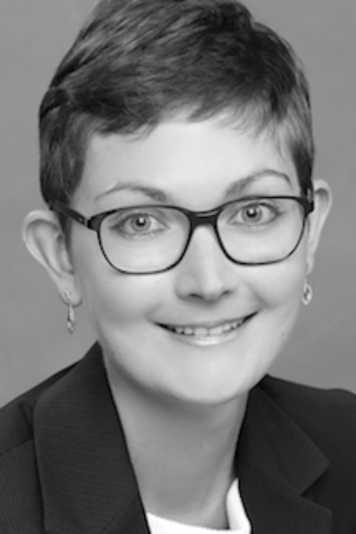
Short CV
Hortense Le Ferrand grew up in Burgundy, France. She obtained a Diplome d’Ingenieur from the Ecole Superieure de Physique et de Chimie Industrielles de la ville de Paris (ESPCI) and an MSc in Materials Science from ETH Zurich. She then earned her Doctoral degree from the Department of Materials at ETH under the supervision of Prof. André Studart in the Complex Materials group. Currently, she is continuing her postdoctoral work at Nanyang Technological University in Singapore.
Your PhD project in 2 sentences
Magnetic fields generate torques and forces driving colloidal particles orientation and position in a low viscosity matrix. Selecting various matrices, particles, and bio-inspired orientations, we can fabricate composite structures with unusual combinations of properties such as optical transparency and electrical conductivity or strength and toughness.
Why did you choose this PhD project?
After doing a master thesis in tissue engineering, I realised how important it is to be able to control the local internal structure of materials as it can directly dictate the state of living cells. I was, therefore, looking for a doctoral project that would tackle material fabrication and assembly. I was already familiar with the concept of bio-inspiration and was really motivated by the multidisciplinary aspect of it as I could use my background in soft matter, chemistry, but also mechanics and electrics while learning about the incredible structures of biology. At the beginning, I focused mostly on reproducing on only one "simple" microstructure. I could not imagine yet the diversity in natural architectures and in properties that can be achieved by copying them. It felt like opening a grimoire, but some recipes were missing.
Future Plans
In my current postdoc work, I’m learning about protein assembly and phase transformations. My ambition is to use these tools to mimic the stiffness gradient of the beak of squids. This is a challenge because the gradient spans from 0.05 to 5 GPa and is entirely composed of organics.
Engineering Inorganic and Cartilage Surfaces by Topologically Different Poly(2-Oxazolines)
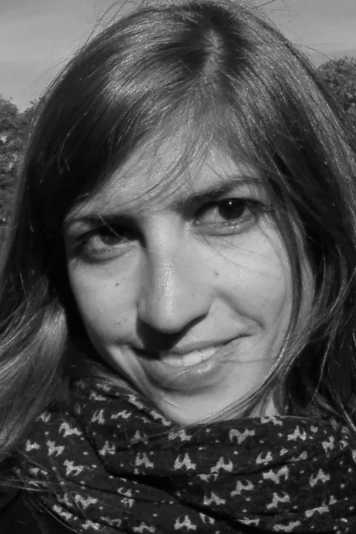
Short CV
Giulia Morgese was born in Italy, and she studied Chemistry at the University of Padova where she obtained her BSc and MSc degree. In 2014 she joined the Polymer Surfaces Group, Laboratory for Surface Science and Technology at ETH Zurich, where she earned her PhD in Material Science under the supervision of Dr. Edmondo Benetti and Prof. Nicholas Spencer. She is currently a postdoc (SNSF fellow) in the group of Prof. Bert Meijer at TU/e, working on supramolecular biomaterials.
Your PhD project in 2 sentences
My PhD project focused on the design and fabrication of polyoxazolines-based coatings featuring simultaneously biopassive and lubricating properties, with the final aim of tackling degenerative articular diseases associated with increased friction and enzymatic degradation, such as osteoarthritis. Through fundamental investigations, the essential parameters to develop the best performing coating were assessed, and among them, the crucial role of polymer topology was unravelled.
Why did you choose this PhD project?
After five years of pure chemistry, the opportunity of combining fundamental and applied science to fabricate materials was my main criteria while looking for a PhD position. Starting from my master thesis, I entered in contact with the fascinating world of surface science, exploring the versatility of polymer grafting as surface modification method. The idea of using it as a tool to face an interdisciplinary project, which ultimately aimed to tackle the worldwide spread issue of osteoarthritis, caught my attention. Finally, since interdisciplinarity means collaboration, I was also attracted by the opportunity of enriching my background and acquire skills in different fields, such as biology, tribology, surface science, polymer chemistry and tissue engineering.
Future Plans
My plan for the future is to continue working on biomaterials. I strongly believe in the importance of nature inspiration in this field, and one of the most fascinating properties of native tissues is their time-evolving feature. I will direct my next steps towards the investigations of essential parameters providing dynamicity to synthetic materials. The final aim is to fabricate molecularly engineered systems prone to transformation.
Particle Based Aerogels: Functional Nanostructured Bulk Materials
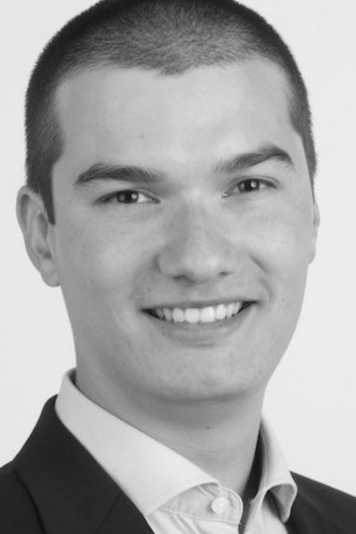
Short CV
Felix Rechberger was born in Vancouver, Canada. He studied Materials Science at ETH Zurich and obtained his MSc in 2013, followed by a PhD under the supervision of Prof. Markus Niederberger at the Laboratory for Multifunctional Materials. After his PhD, he accepted a completely new challenge at SBB. He now develops and improves processes for high-speed safety installation system ETCS L2 as a team leader for verification of safety concepts and plans.
Your PhD project in 2 sentences
In my project, we developed a method to produce aerogels by destabilising highly concentrated nanoparticle dispersions, which caused an assembly into three-dimensionally connected open structures covering seven orders of magnitude of length scale without the use of any templates. In addition, with our modular reactor, we were able to directly apply the cylindrical aerogels in gas phase reactions, thus bypassing their mechanical fragility and making full use of their advantageous features like high surface area and high porosity.
Why did you choose this PhD project?
Aerogels are the highest dimensional (3D) arrangement of nanoparticles and truly connect the nano with the macro world. However, this translucent material is anything but densely packed and just weighs slightly more than the air infiltrating it. Once you have seen or even touched an aerogel for the first time, there seems to be a healthy addiction driving you to explore and investigate more about this fascinating material. My motivation was to expand the compositional variety of aerogels from formerly exclusively silica, metal chalcogenides or metals towards metal oxides with their wide variety of functional properties. Subsequently, we studied their applications in liquid media, which was not very satisfying as the detrimental capillary forces caused the delicate material to disintegrate and therefore losing many of the precious properties. I wanted to make sure the unique features of this material are put to use in a process where they can take full effect and gas phase reactions were the obvious but challenging choice.
Future Plans
Right now I am expanding my horizon in a big company in a completely different environment and developing my skills in management as well as the processes and mechanisms in industry. With my scientific background, I am able to contribute to the systematics of the processes from a different point of view. However, I am certain someday I will find my way back into scientific fields.
MaP Award 2017
Many congratulations to Dr. Loredana Protesescu for winning the MaP Award 2017 for her PhD thesis on "Novel Luminescent Colloidal Nanocrystals and Studies on Nanocrystal Surface Chemistry" which she completed under the supervision of Prof. Maksym Kovalenko in the Functional Inorganic Group (CHAB)! The prize comes with an award of CHF 2500. Together with the other two finalists, Dr. Luca Hirt and Dr. Jessica Schulz, she presented the highlights of her PhD project on the occasion of the MaP Graduate Symposium 2017.
The MaP Award Jury acknowledges the excellent works of all finalists!
Nominees for the MaP Award 2017
Electrochemical Surface Patterning and Additive Manufacturing with FluidFM
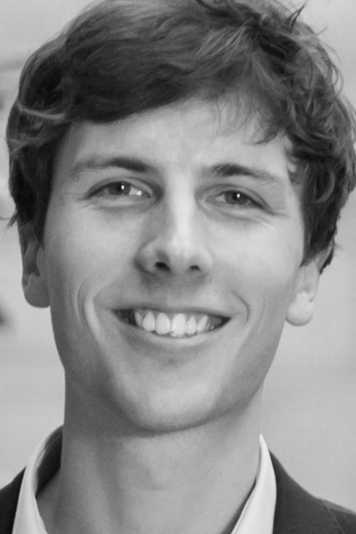
Short CV
Luca Hirt hails from Langenthal, Switzerland. He did his BSc in Electrical Engineering at ETH Zurich, and obtained his MSc in Biomedical Engineering from the same institution in 2012. After short stays at CSEM AG in Landquart and the Swiss Federal Office for the Environment, he pursued his doctoral studies at the Laboratory of Biosensors & Bioelectronics, under the supervision of PD Dr. Tomaso Zambelli. Recently, he co-founded the startup company external page nanoleq.
Your PhD project in 2 sentences
We combined a traditional fabrication process (electroplating) with a modern unique tool (the FluidFM) to enable 3D printing of metals on the micrometer scale.
Why did you choose this PhD project?
I decided to work with the FluidFM because it is an elegant tool combining atomic force microscopy (AFM) with microfluidics. It is essentially a nanopipette with force-sensing capability, making it a versatile technology to answer a broad range of scientific questions. On the other hand, additive manufacturing is a fascinating technology which is still in its beginnings, especially at the micrometer scale, where the traditional fabrication processes are mask-based and thus time-consuming and expensive. A final deciding factor to do this project was the laboratory of biosensors and bioelectronics itself, which convinced me with its highly interdisciplinary projects and its vibrant scientific and social environment.
Future Plans
Our work demonstrated the potential of FluidFM for additive manufacturing on the micrometer scale. The technology will now be further developed, focusing especially on multi-metal printing, the printing of non-metallic materials and 3D printing of biological cells and tissues.
Novel Luminescent Colloidal Nanocrystals and Studies on Nanocrystal Surface Chemistry
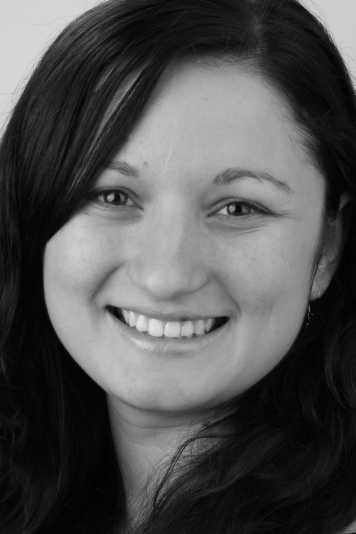
Short CV
Loredana Protesescu was born in Romania. She studied Biochemistry and holds a master degree in Chemistry of Advanced Materials from the University of Bucharest. In 2011, she joined the Functional Inorganic Materials Group at the Laboratory for Inorganic Chemistry, carrying out her PhD studies under the supervision of Prof. Maksym Kovalenko. Currently, Loredana is a Postdoctoral Fellow at MIT, where she is studying new conductive metal organic frameworks – metal halide perovskite hybrid nanocomposites and their opto-electronic properties.
Your PhD project in 2 sentences
This work aimed to fulfil the industry requirements for opto-electronic applications and therefore to develop new materials such as perovskite halide nanocrystals with superior photophysical quality from visible to near-infrared and also we targeted to push the limits of the quantum dots in mid-infrared choosing lead chalcogenides nanocrystals as emitters. The second part, equally important, was represented by the fundamental understanding of the nanocrystals at the atomistic level, which is highly interconnected with the device engineering development since the surface chemistry of the particles oftentimes dictate the quality of their optical properties.
Why did you choose this PhD project?
My PhD projects reflect the needs of every enthusiastic PhD student: the curiosity and the satisfaction to be able to develop new materials right with your own hands and to gain the tools to provide the fundamental understanding for important problems in the field such as surface chemistry of the nanocrystals.
Future Plans
My future career plans are focused on continuous development of my skills and knowledge in the material science and to be actively involved in the development of the opto-eletronic devices from the synthesis of the active materials to the device engineering and commercialization of the product. Currently, I am investigating the opto-electronic properties of the hybrid nanocomposites consisting of conductive metal organic frameworks and metal halide perovskite.
Improving Enzymatic Oral Therapies via Site-Specific Polymer Conjugation
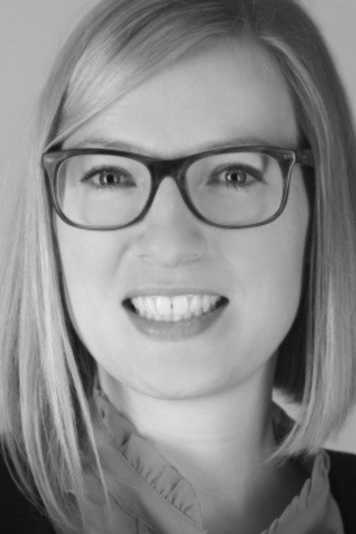
Short CV
Jessica Schulz grew up in Germany and obtained a BSc in Chemistry from the Ruprecht-Karls-University Heidelberg in 2010. In 2012, she gained a MSc in Chemistry from ETH Zurich and subsequently joined the Drug Formulation & Delivery Group at the Institute of Pharmaceutical Sciences at ETH Zurich, where she completed her doctoral studies under the supervision of Prof. Jean-Christophe Leroux. Thereafter, she joined the World Health Organization in Geneva and a local NGO in Tanzania for temporary projects focusing on the undernutrition of children. Currently, Jessica is working as a Postdoc at the Swiss Tropical and Public Health Institute in Basel, where she is involved in Helminth Drug Development.
Your PhD project in 2 sentences
Site-specific polymer conjugation is a tool not only to protect orally delivered enzymes from the harsh conditions in the gastro-intestinal tract, but offers the possibility to retain full activity by avoiding an interaction of the polymers with the active site of the enzyme. PEPs that can degrade gluten, the known trigger of celiac disease, have been successfully site-specifically conjugated with polymers retaining high activity and significantly higher stability in vivo compared to the wild-type enzyme.
Why did you choose this PhD project?
At Karl-Ruprechts University Heidelberg I was trained in basic chemistry causing curiosity to learn about interdisciplinary fields. After several research projects in different groups at ETH Zurich (D-CHAB and D-MATL), pharmaceutical science attracted me the most due to the combination of chemistry, biology and pharmaceutical knowledge and because it applies cutting edge research to health problems. I then took the opportunity to work on this challenging PhD project in the group of Prof Leroux, which convinced me due to its interdisciplinary content and its novel idea to protect orally delivered enzymes. Furthermore, I was attracted by the chance to be responsible for project design, in vitro and in vivo work, meaning that I designed the project’s outline, shaped it over time and finalized it by testing my compounds in an animal model. After four years of intensive work, I can truly tell that I took the right decision due to a steep learning curve and the possibility of building an expert knowledge that significantly shaped my career, and nevertheless due to my ongoing enthusiasm for research during the past years.
Future Plans
Currently, I am building my network in the scientific community of tropical diseases, getting further trained on fundamental research and clinical trials, and on the supervision of group members. Thereby, I am aiming to identify research needs in the field of drug development of neglected & tropical diseases and of human nutrition and its correlation to health to continue with my scientific career.
MaP Award 2016
We cordially congratulate Dr. Gianvito Vilé for winning the MaP Award 2016! He was awarded for his thesis "Design of New Nanostructured Catalysts for Selective Hydrogenations in Flow" which he completed under the supervision of Prof. Javier Pérez-Ramírez in the Laboratory of Advanced Catalysis Engineering (D-CHAB)! Together with the other three finalists, Dr. Ivo Leibacher, Dr. Arabella Mauri and Dr. Christian Peters, he presented the highlights of his PhD project at the MaP Graduate Symposium 2016. Congratulations to all four prize winners for their impressive achievements!
Nominees for the MaP Award 2016
Acoustophoresis of Cells, Core-Shell Particles, Disks and Droplets
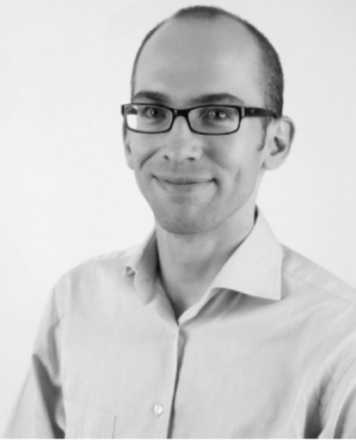
Short CV
Ivo Leibacher grew up in Zurich, Switzerland. He obtained a MSc degree in Mechanical Engineering from ETH Zurich in 2010. After industrial internships in R&D departments both nationally and internationally, he joined the Group of Mechanics and Experimental Dynamics at ETH Zurich, where he carried out his PhD project under the supervision of Prof. Jürg Dual. Currently, he is working on an acoustic R&D project at EMPA.
Your PhD project in 2 sentences
Microscopic particles can be moved and manipulated in a contactless fashion just by applying sound waves. This method called acoustophoresis has been studied in microfluidic chips for applications such as cell focusing, sorting, separation and rotations in a lab-on-a-chip context.
Why did you choose this PhD project?
This research topic offered various undiscovered topics to work on. The opportunity to discover and describe novel effects in matching experiments, numerical simulations and analytical theory was very appealing. I also enjoyed to teach students in mechanics exercises, and last but not least I was happy to team up with some study colleagues at a well-managed institute in the group of Prof. Jürg Dual.
Future Plans
I am looking forward to contribute as an engineer to technical solutions of society’s problems in industrial research & development project teams. Yet as in research, the future career always offers room for discoveries!
Multiscale Mechanical Behavior of Fetal Membranes
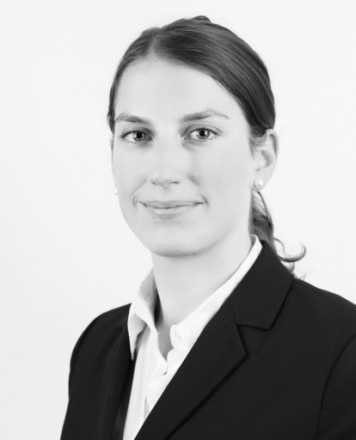
Short CV
Arabella Mauri grew up in Lugano, Switzerland. In 2011, she obtained her MSc degree in Mechanical Engineering from ETH Zurich. She carried out her PhD project in the Group of Experimental Continuum Mechanics at ETH Zurich under the supervision of Prof. Edoardo Mazza. Currently, she is a product development engineer at DePuy Synthes in Switzerland where she is designing and developing implants and instruments for trauma surgeries.
Your PhD project in 2 sentences
The experimental techniques and data analysis algorithms developed in this thesis represent an effective and comprehensive platform of macroscopic and microscopic tools that can be applied to other soft biological tissues, for instance liver capsule, cornea, tissue engineered grafts and collageneous gels. These tools help to develop physically based modeling approaches to represent the multiscale mechanical behaviour of soft biological tissues, and allow the possibility to address their deformation mechanisms at the cellular and tissue length scales.
Why did you choose this PhD project?
This PhD project gave me the possibility to work together with engineers, biologists and physicians to develop suitable prototypes, protocols and post-processing tools to address the multiscale mechanical behaviour of soft collageneous tissues experimentally and with different material modeling approaches.
Future Plans
At the moment I’m focusing on the translation of gained knowledge in specific products, which will bring the technological benefits directly to patients. In future, I plan to remain close to research and to industrial development, since I believe both are needed to achieve excellent innovation and eventually advance society.
Biodegradable Superparamagnetic Polymer Composites: From Material Identification to Device Application
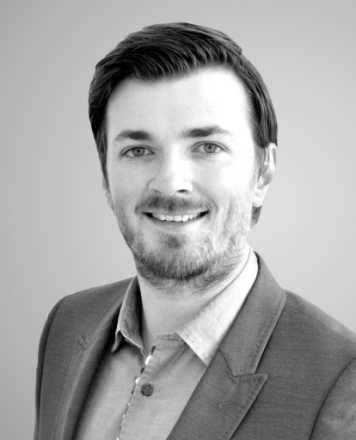
Short CV
Christian Peters hails from Magdeburg, Germany, where he studied Information Technologies and obtained his diploma with distinction from the Otto-von-Guericke University in 2010. After a pre-doctoral research project at the Northwestern University, Evanston/Chicago, United Stated, he joined the Micro and Nanosystems Research Group at ETH Zurich and completed his doctoral studies under the supervision of Prof. Christofer Hierold. Currently, he serves as CTO of the microGauge Project, an ETH spin-off company in foundation concerned with the commercialization of next-generation vacuum pressure sensors.
Your PhD project in 2 sentences
Developing a composite material from scratch allowed the creation of a material that unifies several desirable properties for future biomedical applications in vivo. Hydrogel components allow for bulk diffusion based drug delivery, spatially arranged magnetic nanoparticles enable efficient actuation, and degradable ester linkages permitted the development of the world’s first fully biodegradable magnetic composite microrobot.
Why did you choose this PhD project?
Throughout my studies and my research work, I have been engaged in many interdisciplinary research projects. Thus, the opportunity to forge nanotechnology, material development, and cleanroom processing with biology and device engineering for medical applications appeared as the ultimate challenge. Combined with the opportunity to propel the field of microrobotics towards in vivo applications, I felt that I would not only be engaged in an extremely challenging and interesting research project, but that I could also make an active contribution to future medical procedures that many people may benefit from.
Future Plans
I am not only a passionate researcher and engineer, but also an entrepreneur at heart. As CTO of the microGauge Project, I am able to combine these three interests. Together with two other post-doctoral researchers, we are currently founding the company and are hopeful to establish a successful ETH spin-off company.
Design of New Nanostructured Catalysts for Selective Hydrogenations in Flow
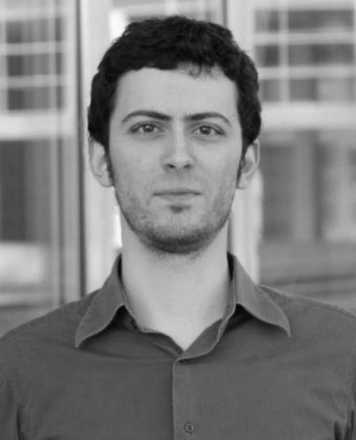
Short CV
Gianvito Vilé was born in Italy. He studied Chemical Engineering at the Politecnico di Milano, Italy, and he was visiting student at the Delft University of Technology, the Netherlands, and at ETH Zurich. After his MSc degree in 2011, he joined the Laboratory of Advanced Catalysis Engineering at the Institute for Chemical and Bioengineering of ETH Zurich, carrying out his PhD studies under the supervision of Prof. Javier Pérez-Ramírez. Currently, he is an R&D engineer at Sensirion and scientific guest at ETH Zurich.
Your PhD project in 2 sentences
This research has originated from the practical need to replace existing catalytic materials which were used for more than six decades in hydrogenation processes, but posing nowadays major environmental and economic concerns due to the presence of noxious compounds (such as lead) and to the poor atom utilization. By employing the most advanced synthetic methods and cutting-edge characterization and evaluation tools, three new families of materials have been discovered and rationalized, showing that the classical strategy of metal poisoning can be brought to a new dimension at the atomic scale.
Why did you choose this PhD project?
When I finished my Master degree, I decided to apply for a PhD project that could combine skills in materials chemistry, nanotechnology, and process engineering. The group of Advanced Catalysis Engineering was an obvious choice due to the multidisciplinary approach applied in the design of heterogeneous catalysts and reactor concepts for challenging reactions. I learned a lot from the tight collaboration with theoreticians and experimental surface scientists in academia and industry. Working in a field that aims at providing the scientific and technological foundation for making cleaner, safer, and more efficient the chemical production could not have been more fascinating.
Future Plans
I believe that other fields can also benefit from new catalyst designing strategies. Currently, I am investigating the use of functionalized and single-atom catalysts in other technologically-relevant applications, ranging from nanoelectronics to drug discovery.
MaP Award 2015
Dr. Sinead Griffin is the winner of the MaP Award 2015! She was awarded for her thesis "From the early universe to the Hubbard Hamiltonian in the hexagonal manganite". Dr. Deniz Bozyigit, Dr. Alexandre Larmagnac and Dr. Martin Süess are recognized for their excellent theses as finalists of this year's award. Congratulations to all four prize winners for their excellent work!
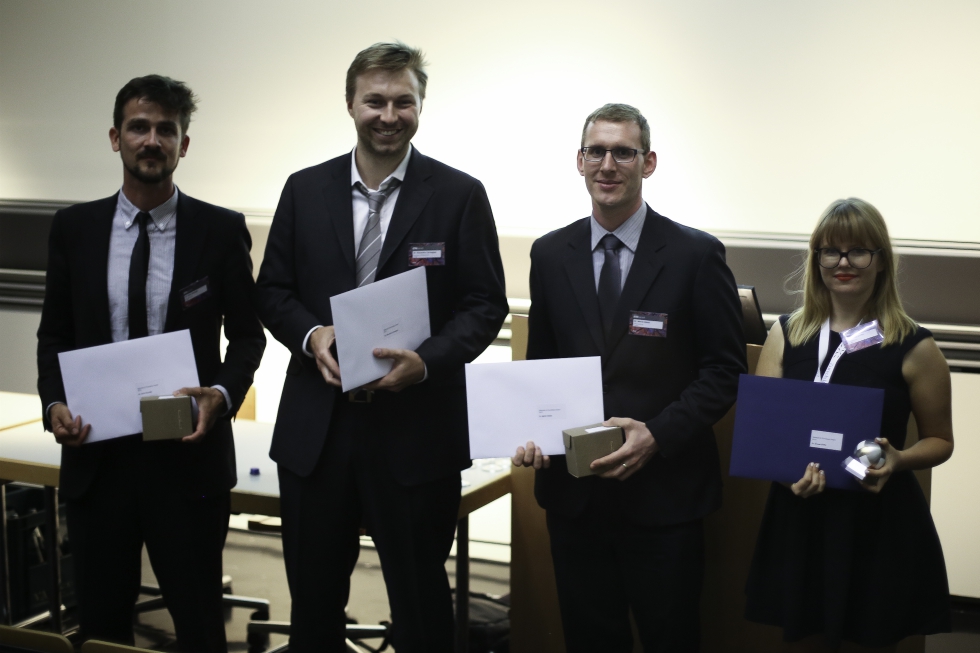
Nominees for the MaP Award 2015
From the early universe to the Hubbard Hamiltonian in the hexagonal manganites
Short CV
Sinead Griffin grew up in Dublin, Ireland. She obtained a BA (Mod) in Theoretical Physics from Trinity College Dublin, an MSc, DIC in Quantum Field and Fundamental Forces from the Imperial College London and an MS in Materials Science from the University of California, Santa Barbara. She then earned her Doctoral degree from the Department of Materials at ETH Zurich under the supervision of Prof. Nicola Spaldin. Currently she is continuing her postdoctoral work at the University of California, Berkeley/Lawrence Berkeley National Lab.
Your PhD project in 2 sentences
The physics of the very large (the Big Bang) and the very small (multiferroic materials) were brought together through the formation and understanding of topological defects in a range of multiferroic materials, verifying an early-universe theory in a crystal for the first time. This gave a universal understanding of domains, domain walls and defects in these particular multiferroics, and allowed the design of a related new material that harbors potential exotic superconductivity.
Why did you choose this PhD project?
Searching for and verifying an early-universe theory in the laboratory was an incredibly exciting and fun process! The opportunity to collaborate and discuss with scientists ranging from cosmologists and string theorists to experimental condensed-matter theorists and chemists gave me a unique breadth of experience across the whole scientific discipline. Moreover, it showed me how a material scientist can both benefit from and contribute to fundamental sciences and cutting-edge discoveries in different fields of research.
Future Plans
I wish to continue to see what other cross-fertilizations can benefit physics and materials science. Currently I am investigating novel and fundamental physics in functional and technologically-relevant materials.
Understanding performance limitations of semiconductor nanocrystal-based optoelectronic devices
Short CV
Deniz Bozyigit was born in Istanbul and obtained his high school diploma in Germany. He studied Information Technology and Electrical Engineering at ETH Zurich and obtained his MSc in 2010. Subsequently he did a PhD at ETH Zurich under the supervision of Prof. Vanessa Wood at the Laboratory for Nanoelectronics. Until recently he was a postdoctoral fellow in Prof. Wood's group and is currently starting as a postdoctoral fellow in the group of Prof. Keith Nelson at MIT in Cambridge.
Your PhD project in 2 sentences
I have investigated and identified the physical processes that limit the efficiency of LEDs and solar cells made from novel nanocrystalline semiconductors. Based on the findings I have proposed new routes to optimize such devices.
Why did you choose this PhD project?
The work on nanocrystalline semiconductor devices continues to excite me, because it strongly integrates different fields of science including quantum- and semiconductor-physics, organic-, inorganic-, and electro-chemistry, and electronic device engineering. At the same time the LED and solar cell devices and the improvement of their efficiencies have direct application in everyday life.
Future Plans
I plan to continue to work on the physics of novel materials with a focus on processes that are relevant for the real life applications of such materials. In particular I plan to focus on the use of advanced spectroscopic techniques.
Highly strained Si and Ge micro- and nanobridges for micro- and optoelectronic applications
Short CV
Martin Süess was born in Lucerne, Switzerland. In 2010 he obtained his MSc in Materials Science from ETH Zurich. His PhD was completed jointly at ETH Zurich and the Paul Scherrer Institute in Villigen under the supervision of Prof. Ralph Spolenak from the Department of Materials. Currently, he is working as a postdoctoral fellow in the group for Quantum Optoelectronics (Prof. Jérôme Faist), designing and fabricating multi-color quantum cascade lasers for a compact 10-gas sensing system.
Your PhD project in 2 sentences
Semiconductor strain technology is an interesting approach to optimize device properties in order to cope with the slowed Moore's law. During my PhD I was part of a team developing and exploring a method to reach record strain in semiconductors, which would either boost their performance or allow them to be used in completely new ways.
Why did you choose this PhD project?
When I started, the project was focused on approaches involving multi-quantum well structures. I was coming from a master thesis about transmission electron microscopy on semiconductors, which I enjoyed very much and so I wanted to expand and deepen my experience. Fortunately, with that background and motivation I was a good fit for the material characterization task of the project. However, after about half a year in the project, the original approach was completely abandoned and shifted towards the micro- and nanobridges. So my original motivation did actually no longer apply, since electron microscopy was no longer a big part of the project and I was even considering to quit. But then the new direction started to evolve and opened a huge scientific playground with fascinating physics. So I decided to keep going, start from scratch and I have never regretted that decision.
Future Plans
In my current postdoc work, I’m learning about device fabrication and simulation. My ambition is to combine the strain engineering approach with device fabrication on other materials besides Si and Ge, which would allow to access new ranges of device properties and performances.
Novel neuroprosthetic devices for spinal cord stimulation in paralyzed animals
Short CV
Alexandre Larmagnac hails from France. He obtained an MSc degree in Electrical Engineering from the Ecole Supérieure d'Electricité, France and in Biomedical Engineering from ETH Zurich in 2008. He then joined the Laboratory for Biosensors & Bioelectronics at ETH Zurich, where he carried out his PhD project under the supervision of Prof. Janos Vörös. Currently, he is working on focus tunable lenses as a product development engineer at Optotune AG, Switzerland.
Your PhD project in 2 sentences
This PhD project investigated the use of conductive composite elastomers and processes for the fabrication of a novel type of miniature neuroprostheses with unmatched mechanical properties that enabled for the first time chronic epidural electrical stimulation in mice. Our process allowed us to pattern 3D structures of nanowire-based composite electrodes on the micron scale with unprecedented level of control over their electrical properties, which is important for applications like stretchable displays or solar panels.
Why did you choose this PhD project?
When I left France to join the Master of Biomedical Engineering at the ETH Zurich, I told my friends about my dream to make paraplegic people walk again. Two years later, I actually was offered the opportunity to design the implants that will restore locomotion in paralyzed animals and maybe one day in patients. I surely said yes!
Future Plans
I am now gathering experience in industry on how to successfully transform an idea into a viable product with high impact on society. I am particularly interested in the use of stretchable electronics for the design of revolutionary products.
MaP Award 2014
The MaP Award 2014 goes to Dr. Rafael Libanori for his thesis "Bioinspired composites with controlled alignment and distribution of anisotropic reinforcing particles". We would also like to congratulate the three runners-up, Dr. Matthias Muoth, Dr. Johannes Haberl and Dr. Martina Hitzbleck for their excellent work and presentation.
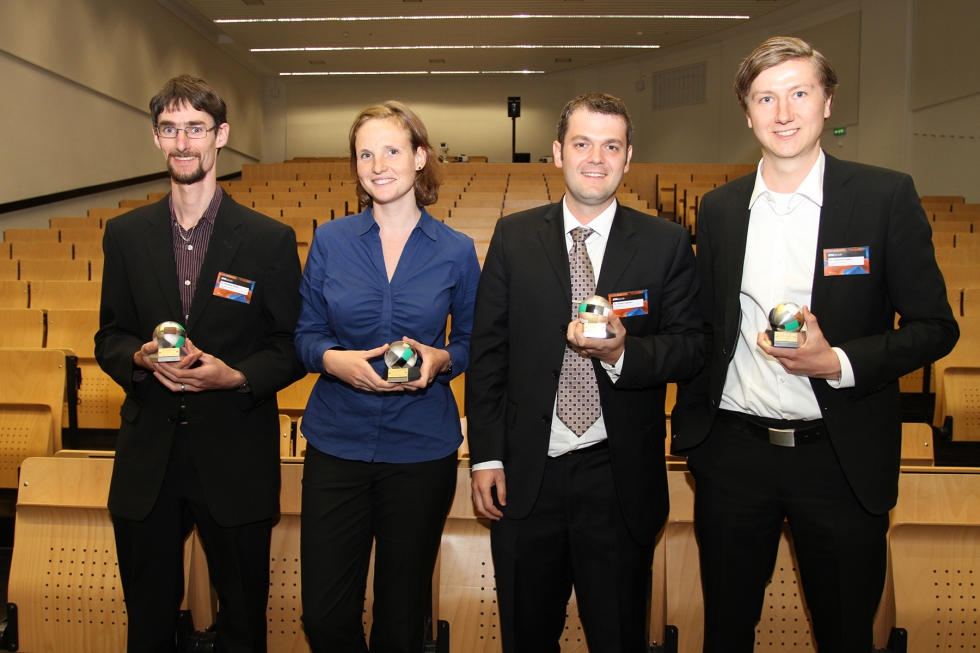
Nominees for the MaP Award 2014
Bioinspired composites with controlled alignment and distribution of anisotropic reinforcing particles
Short CV
Rafael Libanori hails from Brazil, where he studied Chemistry (BSc) and Materials Science and Engineering (MSc) at the Federal University of São Carlos. After his graduation in 2009, he joined the laboratory for Complex Materials at the Department of Materials at ETH Zurich, where he carried out his PhD project under the supervision of Prof. André R. Studart. Currently, he is continuing his work as a postdoctoral researcher in the same group.
Your PhD project in 2 sentences
This PhD project investigated the directed-assembly of platelet-reinforced composites that incorporate some of the design principles found in the underlying microstructure of natural materials. Such approach allowed us to fabricate high-performance artificial composites with an unprecedented level of control over their microstructures.
Why did you choose this PhD project?
At the time when I was concluding my Master degree, I had already decided to apply for PhD projects with topics related to fundamental science or applied materials chemistry. However, during the interview for this PhD position, I realized how fascinating is the research on bio-inspired materials: the multidisciplinary approach and the challenge for the implementation of design principles on artificial composites, which have been ceaselessly fine-tuned by natural selection through millions of years to optimize the mechanical performance of biological materials, were certainly the main reasons that led me to choose this project.
Future Plans
My plan is to continue working on the research and development of advanced composites for structural and energy-related applications. In the future, I would like to add a little touch of chemistry to the design of bio-inspired composites so that their mechanical performance can be improved even further.
Magnetic liquid-crystalline elastomers
Short CV
Johannes Haberl grew up in Schrobenhausen, Germany. He studied Chemistry at the Albert-Ludwigs-University in Freiburg i. Br. During that time he spent a semester at the University Pierre et Marie Curie in Paris. He then specialized in Macromolecular Chemistry and graduated in 2010 with Prof. Finkelmann to join the ETH in Zurich, where he earned his Doctoral degree from the Department of Health, Science and Technology under the supervision of Prof. Raffaele Mezzenga. Currently he is working in the Material Science Department at the Goodyear Innovation Center in Luxembourg.
Your PhD project in 2 sentences
A smart material was synthesized which couples the permanent magnetic properties of shape anisotropic nanospindles to the elastic properties of liquid-crystalline polymer networks. Mechanic deformation and light stimulation, both are used to control the macroscopic magnetic properties of this soft elastomer.
Why did you choose this PhD project?
At the interphase of fundamental research and applied science this project offered a huge variety of challenging topics from organic, inorganic and polymer chemistry to liquid crystals, networks and magneto-physics. Moreover, I had the chance to work in the dynamic spirit of an international group with cross-functional cooperations, embedded in the infrastructure of ETH and located in a great city.
Future Plans
Working at the border of fundamental and applied science has become a welcome challenge for me in order to achieve sustainable innovation.
Advanced Capillary-driven Microfluidic Chips for Diagnostic Applications
Short CV
Martina Hitzbleck was born in Heiligenhaus, Germany. In 2009 she obtained her MSc in Physics from RWTH Aachen University in Germany. Her PhD was completed jointly at the Laboratory for Biosensors & Bioelectronics at ETH Zurich under the supervision of Prof. Janos Vörös and in the Experimental Biosciences Group at IBM Research-Zurich under Dr. Emmanuel Delamarche. Currently, she is working in the Sensor Innovation Team at Sensirion AG, Switzerland.
Your PhD project in 2 sentences
In analogy to traditional biochemical analysis where reagents are manually mixed and dosed in a lab, a network of hydrophilic microchannels can perform liquid handling and biochemical reactions in a pre-programmed way. During my PhD I developed multifunctional microfluidic networks, which are particularly interesting for medical diagnostics, because they enable a doctor to scan for antigens or bacterial infections in a patient´s blood sample faster and more precise while consuming less reagents than current technologies.
Why did you choose this PhD project?
The idea of understanding solid-liquid interactions on a fundamental level and using these insights in the development of real applications fascinated me and was a good fit with my background in solid state physics and biomolecular interactions. Furthermore, the PhD project was embedded in an EU funded project involving experienced researchers at universities, research institutions, diagnostic companies, hospitals and chip manufacturers, which resulted in a very interdisciplinary and exciting atmosphere to work in.
Future Plans
As a next step, I want to gather experience in industry and understand the challenges of taking a fundamental concept from research to a final product on the market, with visible use for our society.
Clean Integration of Single-Walled Carbon Nanotubes for Electromechanical Systems
Short CV
Matthias Muoth was born in Zug, Switzerland, and received his Matura in Zofingen. He studied Mechanical and Process Engineering at ETH Zurich and obtained his MSc in 2007. Subsequently he did a PhD at ETH Zurich under the supervision of Prof. Christofer Hierold in the field of carbon nanotubes. Currently he is a postdoc in Prof. Hierold's group of Micro and Nanosystems.
Your PhD project in 2 sentences
Fabrication processes for carbon nanotube transistors were developed and enabled ultraclean gas sensors as well as mechanically strained devices. The measured piezoresistive response of strained transistors combined with molecular structure assignment allowed confirming theoretical predictions for nanotubes acting as displacement and force sensors.
Why did you choose this PhD project?
The opportunity to develop processes for nano-scale devices and learn more about microscopy has been very appealing. Moreover, knowing the ambitious group of Prof. Hierold from student projects, I have been looking forward to join his group working in a well-equipped research environment.
Future Plans
From concepts to innovations: I am looking forward to becoming a member of a product-oriented team within industrial research and development.
